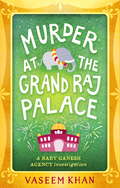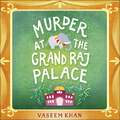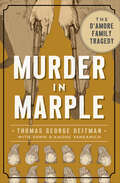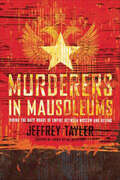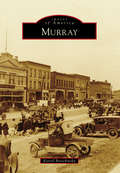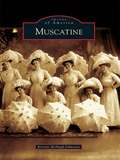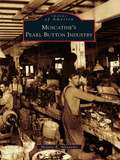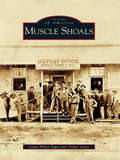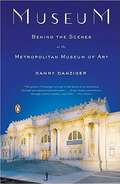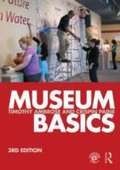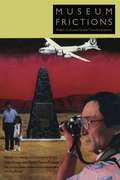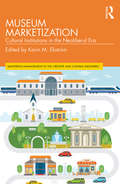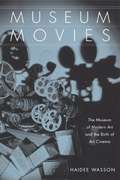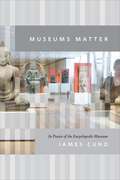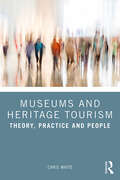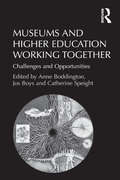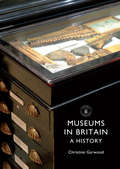- Table View
- List View
Murder at the Grand Raj Palace: Baby Ganesh Agency Book 4 (Baby Ganesh series)
by Vaseem KhanIn this enchanting Baby Ganesh Agency novel, Inspector Chopra and his elephant sidekick investigate a murder at Mumbai's grandest hotel.For a century Mumbai's iconic Grand Raj Palace Hotel has welcomed the world's elite. Anyone who is anyone stays at the Grand Raj. The last thing the venerable old hotel needs is a murder . . .So when the body of American billionaire Hollis Burbank is found, the pressure is on to label it a suicide. But then Chopra is called in . . . and finds a hotel full of people with a reason to want Burbank dead. Accompanied by his sidekick, baby elephant Ganesha, Chopra navigates his way through the palatial building, a journey that leads him steadily to a killer, and into the heart of darkness . . .PRAISE FOR THE SERIES'A most beguiling series' Financial Times'Utterly charming' Guardian'Colour and atmosphere flows out of every page' Daily Express
Murder at the Grand Raj Palace: Baby Ganesh Agency Book 4 (Baby Ganesh series)
by Vaseem KhanIn the enchanting new Baby Ganesh Agency novel, Inspector Chopra and his elephant sidekick go undercover to investigate a murder at Mumbai's grandest hotel.For a century the iconic Grand Raj Palace Hotel has welcomed the world's elite. From film stars to foreign dignitaries, anyone who is anyone stays at the Grand Raj. The last thing the venerable old hotel needs is a murder...When American billionaire Hollis Burbank is found dead - the day after buying India's most expensive painting - the authorities are keen to label it a suicide. But the man in charge of the investigation is not so sure. Chopra is called in - and discovers a hotel full of people with a reason to want Burbank dead.Accompanied by his sidekick, baby elephant Ganesha, Chopra navigates his way through the palatial building, a journey that leads him steadily to a killer, and into the heart of darkness . . .(P)2018 Hodder & Stoughton Limited
Murder in Marple: The D’Amore Family Tragedy (True Crime)
by Thomas George DeitmanBenjamin D'Amore abused his wife for the last time on November 29, 1949. That night, his sons John and Nicholas exacted revenge and executed Benjamin with a shotgun and deer rifle. The trial that followed was unlike many before it. Two psychiatrists diagnosed the brothers with "catathymic crisis," which inhibited their judgment during the crime. But despite the defendants' guilty plea, an all-female jury acquitted them. Thomas Deitman and Dawn D'Amore Yankanich unravel the horrific events and conspiracies regarding the shocking patricide case.
Murderers In Mausoleums: Riding the Back Roads of Empire Between Moscow and Beijing
by Jeffrey TaylerA gripping journey through some of the planet&’s most remote and challenging terrain and its peoples, in search of why democracy has yet to thrive in lands it seemed so recently ready to overtake Across the largest landmass on earth, in lands once conquered by Genghis Khan and exploited by ruthless Communist regimes, autocratic and dictatorial states are again arising, growing wealthy on petrodollars and low-cost manufacturing. More and more, they are challenging theWest. Media reports focus on developments in Moscow and Beijing, but the peoples inhabiting the vast expanses in between remain mostly unseen and unheard, their daily lives and aspirations scarcely better known to us now than they were in ColdWar days.Tayler finds, among many others, a dissident Cossack advocating mass beheadings, a Muslim in Kashgar calling on the United States to bomb Beijing, and Chinese youths in Urumqi desiring nothing more than sex, booze, and rock &’n&’ roll—all while confronting over and over again the contradiction of people who value liberty and the free market but idealize tyrants who oppose both. From the steppes of southern Russia to the conflict-ridden Caucasus Mountains to the deserts of central Asia and northern China,Tayler shows that our maps have gone blank at the worst possible time.
Murray
by Korral BroschinskyA community of scattered homesteads had its first encounter with industry in the 1870s when smelters were established near the railroad. Later, with a burgeoning business district and hundreds of immigrant workers arriving each year, the citizens of Murray pushed for incorporation, which was granted in 1903. In the first half of the 20th century, the industrial town was one of the most ethnically diverse cities in Utah. Murray City was hailed as an example of an independent municipality with its own power plant, waterworks, school district, and so on. The commercial core was surrounded by dairies, poultry ranches, and truck farms. Murray was one of the first cities in Salt Lake County to experience a postwar suburban boom in the 1950s and continues to thrive today as more than just a bedroom community.
Muscatine
by Kristin Mchugh-JohnstonMuscatine, situated on one of the largest east-west bends of the Mississippi River, grew from a small territorial trading post into an Iowa community rich in agricultural bounty and manufacturing ingenuity. Mussels harvested from the mighty Mississippi propelled the city to the status of the "Pearl Button Capital of the World" by the turn of the 20th century. Booming lumber yards, sash and door manufacturers, and the first H. J. Heinz canning facility built outside of Pittsburg added to the town's growth and prosperity. An aspiring writer named Samuel Clemens, civil rights pioneer Alexander Clark Sr., the self-proclaimed cancer cure of Norman Baker, and other notables add even more texture to the town's rich heritage. The story of Muscatine is traced through these businesses and the men and women who left a legacy of work ethic that defines the Midwest.
Muscatine's Pearl Button Industry
by Melanie K. AlexanderThe Mississippi River town of Muscatine produced billions of pearl buttons. By 1905, Muscatine made 37 percent of the world's buttons and earned the title of "Pearl Button Capital of the World." The rise and fall of the pearl button occurred over a period of 75 years. John Frederick Boepple, a German immigrant button maker, launched the industry in 1891. The button and clamming industries started small but quickly overwhelmed the town. Clamming became the Mississippi River's gold rush while large automated factories and shell-cutting shops employed nearly half the local workforce. Entire families--men, women, and children--contributed to the industry, giving weight to the popular local saying "No Muscatine resident can enter Heaven without evidence of previous servitude in the button industry." Although the industry peaked in 1916, several decades passed before the American-made pearl button buckled under the pressure of foreign competition, changing fashion, limited availability of shell, and the development and refinement of plastic buttons.
Muscle Shoals
by Laura Flynn Tapia Yoshie LewisLong known as "the Shoals," Muscle Shoals saw its formal birth as an incorporated city in 1923. It really sprang to life in 1933, when the Tennessee Valley Authority took shape on the Tennessee River and became the nation's largest public power company. The construction crew for the Wilson Dam and power plant was one of the region's first racially integrated workforces. Some truly influential figures of the 20th century came to Muscle Shoals to witness firsthand what was unfoldingin this tiny corner of the world. Thomas Edison and Henry Ford found themselves drawn to Wilson Dam and the nitrate plants in the early 1920s, as did the French existentialist Jean-Paul Sartre. At one time,Muscle Shoals was regarded as the hit recording capital of the world. FAME studio musicians referred to as the Muscle Shoals Rhythm Section gained notoriety as a result of the studio's success and are part of the legacy of the Muscle Shoals sound.
Museum
by Danny DanzigerAn ?intriguing? oral portrait of the people behind the Metropolitan Museum of Art (Entertainment Weekly) Using more than fifty interviews, award-winning writer Danny Danziger creates a fascinating mosaic of the people behind New York?s magnificent Metropolitan Museum of Art. From the aristocratic, acerbic director of the museum, Philippe de Montebello, to the curators who have a deep knowledge and passionate appreciation of their collections, from the security guards to the philanthropists who keep the museum?s financial life blood flowing, Danziger brings to life this extraordinary world through the words of those who are devoted to making the Met the American institution it surely is. .
Museum ABC (Metropolitan Museum Of Art #1)
by The Metropolitan Museum of ArtMuseum ABC is a unique and colorful picture book that introduces children to more than a hundred works of art, using the alphabet. Adults and children alike will love the visual and cultural richness of this alphabetical tour through the Metropolitan Museum's collection.
Museum Basics
by Timothy Ambrose Crispin PaineMuseums throughout the world have common needs and face common challenges. Keeping up-to-date with new ideas and changing practice is challenging for small and medium-sized museums where time for reading and training is often restricted. This new edition of Museum Basics has therefore been produced for the many museums worldwide that operate with limited resources and few professional staff. The comprehensive training course provided within the book is also suitable for museum studies students who wish to gain a full understanding of work within a museum. Drawing from a wide range of practical experience, the authors provide a basic guide to all aspects of museum work, from audience development and education, through collections management and conservation, to museum organisation and forward planning. Organised on a modular basis with over 110 Units, Museum Basics can be used as a reference work to assist day-to-day museum management and as the key textbook in pre-service and in-service training programmes. It is designed to be supplemented by case studies, project work and group discussion. This third edition has been fully updated and extended to take account of the many changes that have occurred in the world of museums in the last five years.
Museum Frictions: Public Cultures/Global Transformations
by Ivan Karp Corinne A. Kratz Lynn Szwaja Tomás Ybarra-FraustoMuseum Frictions is the third volume in a bestselling series on culture, society, and museums. The first two volumes in the series, Exhibiting Cultures and Museums and Communities, have become defining books for those interested in the politics of museum display and heritage sites. Another classic in the making, Museum Frictions is a lavishly illustrated examination of the significant and varied effects of the increasingly globalized world on contemporary museum, heritage, and exhibition practice. The contributors--scholars, artists, and curators--present case studies drawn from Africa, Australia, North and South America, Europe, and Asia. Together they offer a multifaceted analysis of the complex roles that national and community museums, museums of art and history, monuments, heritage sites, and theme parks play in creating public cultures. Whether contrasting the transformation of Africa's oldest museum, the South Africa Museum, with one of its newest, the Lwandle Migrant Labor Museum; offering an interpretation of the audio guide at the Guggenheim Bilbao; reflecting on the relative paucity of art museums in Peru and Cambodia; considering representations of slavery in the United States and Ghana; or meditating on the ramifications of an exhibition of Australian aboriginal art at the Asia Society in New York City, the contributors highlight the frictions, contradictions, and collaborations emerging in museums and heritage sites around the world. The volume opens with an extensive introductory essay by Ivan Karp and Corinne A. Kratz, leading scholars in museum and heritage studies. Contributors. Tony Bennett, David Bunn, Gustavo Buntinx, Cuauhtmoc Camarena, Andrea Fraser, Martin Hall, Ivan Karp, Barbara Kirshenblatt-Gimblett, Corinne A. Kratz, Christine Mullen Kreamer, Joseph Masco, Teresa Morales, Howard Morphy, Ingrid Muan, Fred Myers, Ciraj Rassool, Vicente Razo, Fath Davis Ruffins, Lynn Szwaja, Krista A. Thompson, Leslie Witz, Toms Ybarra-Frausto
Museum Marketization: Cultural Institutions in the Neoliberal Era (Mastering Management in the Creative and Cultural Industries)
by Karin M. EkströmThis wide-ranging book explores the impact of marketization on the creative industries. With critical perspectives from a variety of disciplines and global experts, numerous examples from international cultural institutions are employed to illuminate the topic. Culture and business have become increasingly intertwined, and cultural institutions need to be aware of their place in the market. Commercial awareness, which was previously disparaged, is now seen as a legitimate and necessary response to increased competition, enhancing experience, increasing accessibility, broadening inclusivity and sustainable futures with diminishing funding. The contributions to this book highlight that marketing, public relations, sponsorship and fundraising have become integral to the survival of many museums, galleries and events. Of interest to students and scholars across topics such as arts marketing, arts administration, heritage marketing and museum studies, the book is also insightful for reflective practitioners in the creative sector.
Museum Movies: The Museum of Modern Art and the Birth of Art Cinema
by Haidee WassonHaidee Wasson provides a rich cultural history of cinema's transformation from a passing amusement to an enduring art form by mapping the creation of the Film Library of the Museum of Modern Art (MoMA), New York, established in 1935. The film library pioneered an expansive moving image network, comprising popular, abstract, animated, American, Canadian, and European films.
Museums Matter
by James CunoThe concept of an encyclopedic museum was born of the Enlightenment, a manifestation of society’s growing belief that the spread of knowledge and the promotion of intellectual inquiry were crucial to human development and the future of a rational society. But in recent years, museums have been under attack, with critics arguing that they are little more than relics and promoters of imperialism. Could it be that the encyclopedic museum has outlived its usefulness? With Museums Matter, James Cuno, president and director of the Art Institute of Chicago, replies with a resounding “No!” He takes us on a brief tour of the modern museum, from the creation of the British Museum—the archetypal encyclopedic collection—to the present, when major museums host millions of visitors annually and play a major role in the cultural lives of their cities. Along the way, Cuno acknowledges the legitimate questions about the role of museums in nation-building and imperialism, but he argues strenuously that even a truly national museum like the Louvre can’t help but open visitors’ eyes and minds to the wide diversity of world cultures and the stunning art that is our common heritage. Engaging with thinkers such as Edward Said and Martha Nussbaum, and drawing on examples from the politics of India to the destruction of the Bramiyan Buddhas to the history of trade and travel, Cuno makes a case for the encyclopedic museum as a truly cosmopolitan institution, promoting tolerance, understanding, and a shared sense of history—values that are essential in our ever more globalized age. Powerful, passionate, and to the point, Museums Matter is the product of a lifetime of working in and thinking about museums; no museumgoer should miss it.
Museums and Heritage Tourism: Theory, Practice and People
by White ChrisThis book examines the symbiotic relationship between museums, heritage attractions and tourism, using a range of international case studies. Divided into three clear sections, the author first outlines a theoretical framework for understanding the role of museums in heritage tourism, before addressing practical challenges of interpretation, design and pandemic response. Finally, he traces the development of museum and heritage attraction design through the key figures of John Ruskin, James Gardner and Alex McCuaig. Each chapter incorporates a key case study, with an international scope including examples from Hong Kong, the UK, Taiwan, Qatar, Dubai and Kuwait. An essential introduction for undergraduate and graduate students taking courses in museum studies, heritage studies, and tourism management.
Museums and Higher Education Working Together: Challenges and Opportunities
by Jos BoysOver the last twenty years the educational role of the museum has come to be central to its mission. There are now far more educational opportunities, new spaces, new interfaces - both digital and physical, and a growing number of education and interpretation departments, educational curators and public engagement programmes. Despite these developments, however, higher education has remained a marginal collaborator compared to primary and secondary schools and to other forms of adult learning. This has meant that the possibilities for partnerships between universities, colleges, museums and galleries has remained relatively unexplored, especially in relation to their potential for generating innovative patterns of research and learning. This book addresses the key issues which are preventing such partnerships and examines how to enable more effective and creative connections between museums and higher education. The authors identify conceptual and practical barriers and explore whether current academic models are fit for purpose. They argue that as pressures mount on public educational resources around the world, there needs to be an urgent increase in the exchange of knowledge across these sectors and the forging of world-class scholarly partnerships. Examples of research undertaken internationally offer best practice models for collaboration and integration. This book will be compulsory reading for museum and educational specialists and those interested in engaging in museum/higher education partnerships. It will also be of interest to those involved in policy and decision-making in education, the museum sector and national and local government.
Museums in Britain
by Christine GarwoodMuseums are at the heart of the nation's cultural life, bastions of Britishness in almost every major city and town. Together they detail myriad aspects of our heritage: from lawnmowers to cuckoo clocks, pencils to chairs, there seems to be no end to the subject matter deemed worthy of collection and public display. This overview of museums in Britain traces their development from 'cabinets of curiosity' to large scale visitor attractions, taking in broad social shifts and trends as well as the collectors, eccentrics and visionaries and the legacies they have left.
Museums of Communism: New Memory Sites in Central and Eastern Europe
by Stephen M. NorrisHow did communities come to terms with the collapse of communism? In order to guide the wider narrative, many former communist countries constructed museums dedicated to chronicling their experiences. Museums of Communism explores the complicated intersection of history, commemoration, and victimization made evident in these museums constructed after 1991. While contributors from a diverse range of fields explore various museums and include nearly 90 photographs, a common denominator emerges: rather than focusing on artifacts and historical documents, these museums often privilege memories and stories. In doing so, the museums shift attention from experiences of guilt or collaboration to narratives of shared victimization under communist rule. As editor Stephen M. Norris demonstrates, these museums are often problematic at best and revisionist at worst. From occupation museums in the Baltic States to memorial museums in Ukraine, former secret police prisons in Romania, and nostalgic museums of everyday life in Russia, the sites considered offer new ways of understanding the challenges of separating memory and myth.
Mushrooms of Alaska (A Timber Press Field Guide)
by Noah Siegel Steve Trudell Kate MohattIdeal for foragers, hikers, and birders, Timber Press Field Guides are the perfect tools for loving where you live From the leading experts on Northwest mycology comes this comprehensive field guide to the most conspicuous, distinctive, and ecologically important mushrooms found in the Last Frontier. With helpful identification keys and photographs and a clear, color-coded layout, Mushrooms of Alaska is the perfect companion for locals and visitors alike. Describes and illustrates more than 400 species of fungi Over 500 spectacular photographs, with additional keys and diagrams Includes rare species not illustrated in other guides Easy to use for beginners and experts
Mushrooms of the Northeastern United States and Eastern Canada: Timber Press Field Guide (A Timber Press Field Guide)
by Timothy J. BaroniA must-have for mushroom hunters in the northeast The Northeast is one of the best places to find mushrooms; they are both abundant and spectacularly diverse. Mushrooms of the Northeastern United States and Eastern Canada is a compact, beautifully illustrated guide packed with descriptions and photographs of more than 400 of the region's most conspicuous, distinctive, and ecologically important mushrooms. The geographic range covered by the book includes Connecticut, Delaware, Illinois, Indiana, Maine, Massachusetts, Minnesota, New Hampshire, New Jersey, New York, Ohio, Pennsylvania, Rhode Island, Vermont, Wisconsin, and the Canadian provinces of New Brunswick, Newfoundland, Ontario, and most of Quebec. In addition to profiles on individual species, Mushrooms of the Northeastern United States and Eastern Canada also includes a general discussion and definition of fungi; information on where to find mushrooms and guidelines on collecting them; an overview of fungus ecology; and a discussion on mushroom poisoning and how to avoid it.
Mushrooms of the Pacific Northwest, Revised Edition (A Timber Press Field Guide)
by Steve TrudellIdeal for hikers, foragers, and naturalists, the Timber Press Field Guides are the perfect tools for loving where you live.Mushrooms of the Pacific Northwest is a comprehensive field guide to the most conspicuous, distinctive, and ecologically important mushrooms found in the region. With helpful identification keys and photographs and a clear, color-coded layout, Mushrooms of the Pacific Northwest is ideal for hikers, foragers, and natural history buffs and is the perfect tool for loving where you live. Covers Oregon, Washington, and British Columbia Describes and illustrates 493 species 530 photographs, with additional keys and diagrams Clear color-coded layout
Mushrooms of the Pacific Northwest: Timber Press Field Guide (A Timber Press Field Guide)
by Joe Ammirati Steve TrudellExplore the heart of mushroom country The Pacific Northwest is one of the best places to find mushrooms—they are both abundant and spectacularly diverse. Yet until now, there has been no mushroom guide that focuses on the region. This compact, beautifully illustrated guide presents descriptions and photographs of 460 of the region's mushrooms. In addition to profiles on individual species, Mushrooms of the Pacific Northwest also includes a general discussion and definition of fungi, information on where to find mushrooms and guidelines on collecting them, an overview of fungus ecology, and a discussion on how to avoid mushroom poisoning.
Mushrooms of the Southeast: Timber Press Field Guide (A Timber Press Field Guide)
by Steven L. Stephenson Todd F. ElliottMushrooms of the Southeast is a compact, beautifully illustrated guide packed with descriptions and photographs of more than 400 of the region’s most important mushrooms. The geographic range covered by the book includes northern Florida, Georgia, South Carolina, North Carolina, Virginia, Delaware, Maryland, West Virginia, Kentucky, Tennessee, Arkansas, Louisiana, Mississippi, and Alabama. In addition to profiles on individual species, the book also includes a general discussion and definition of fungi, information on where to find mushrooms and collection guidelines, an overview of fungus ecology, and information on mushroom poisoning and how to avoid it.
Music and Tourism
by Chris Gibson John ConellMusic and Tourism is the first book to comprehensively examine the links between travel and music. It combines contemporary and historical analysis of the economic and social impact of music tourism, with discussions of the cultural politics of authenticity and identity. Music tourism evokes nostalgia and meaning, and celebrates both heritage and hedonism. It is a product of commercialisation that can create community, but that also often demands artistic compromise. Diverse case studies, from the USA and UK to Australia, Jamaica and Vanuatu, illustrate the global extent of music tourism, its contradictions and pleasures.
